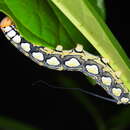mk
имиња во трошки


Isognathus menechus is a moth of the family Sphingidae.
It is found from Cuba to Bolivia, Argentina and Brazil.[2]
It is a heavy-bodied species. The upperside of the body and forewings has a bluish-grey cast and the bands on the upperside of the abdomen are well marked.[3]
There are probably multiple generations per year.
The larvae have been recorded feeding on Himatanthus lancifolius. They have long tails and are very colourful, suggesting they are unpalatable to birds.
Isognathus menechus is a moth of the family Sphingidae.
Isognathus menechus est une espèce d’insectes lépidoptères de la famille des Sphingidae, de la sous-famille des Macroglossinae, de la tribu des Dilophonotini.
C'est une espèce à corps lourd. La partie supérieure du corps et des ailes antérieures présente une dominante gris bleuâtre et les bandes situées sur la partie supérieure de l'abdomen sont bien marquées.
L'espèce est multivoltine, avec des adultes qui volent pendant tous les mois de l'année. Les chenilles se nourrissent sur Himatanthus lancifolius.
L'espèce Isognathus menechus a été décrite par le naturaliste français Jean-Baptiste Alphonse Dechauffour de Boisduval en 1875 [1].
Isognathus menechus est une espèce d’insectes lépidoptères de la famille des Sphingidae, de la sous-famille des Macroglossinae, de la tribu des Dilophonotini.
Isognathus menechus (Boisduval, [1875]) è un lepidottero appartenente alla famiglia Sphingidae, diffuso in America Meridionale.[1]
La pagina superiore dell'ala anteriore è di color grigio-cenere, e mostra un paio di linee trasversali più scure che, seppur separate all'altezza della costa, si riavvicinano posteriormente, per poi interrompersi all'altezza di M3; posteriormente a questa nervatura, riappaiono assumendo una tonalità più marcata e la forma di un semicerchio aperto in prossimità del tornus. In alcuni esemplari è inoltre osservabile una macchia nerastra allungata tra M3 e CuA1.[1][2][3][4] Nella femmina, le tonalità sono meno contrastanti.[3] La parte distale delle nervature tende al bianco.[1][3]
La pagina inferiore ricorda quella di I. excelsior, essendo tinta di un marroncino alquanto uniforme (più pallido che in I. excelsior), con striature trasversali di colore più intenso.[3]
L'ala posteriore è gialla per i tre quarti basali, ma mostra una banda marrone che parte dall'ultimo quarto della costa e giunge, con larghezza variabile e margine interno dentellato, fino all'angolo anale, dove si stempera in una macchia più sbiadita, di colore analogo al fondo dell'ala anteriore, occupando l'intera lunghezza del termen.[2][3][4]
La pagina inferiore, anch'essa simile a quella di I. excelsior, rivela invece una larga banda costale marroncina, lievemente più ampia nella femmina, che prosegue anche per tutto il margine esterno fino all'angolo anale; il resto della superficie dell'ala è campito di una tonalità di giallo analoga a quella della superficie dorsale.[3]
L'apice dell'ala anteriore non è falcato. Il termen è lievemente dentellato in ambo i sessi, ma soltanto nell'ala posteriore.[3]
Le antenne sono filiformi e uncinate all'estremità, con una lunghezza di poco inferiore alla metà della costa.[2][3][4]
Il torace è scuro dorsalmente, ma risulta grigio cenere sulla superficie ventrale.[2][3]
L'addome rivela, a livello dei tergiti, bande trasversali ben distinguibili (a differenza di quanto osservabile in altre specie congeneri), mentre sul ventre assume lo stesso colore cenerino del torace.[2][3]
L'apertura alare del maschio è di 90–92 mm, mentre quella della femmina arriva fino a 100 mm.[4]
Il bruco è cilindrico, con capo piccolo e tondeggiante. Il cornetto caudale sull'ottavo urotergite è affusolato e molto lungo. La colorazione vivace suggerisce che possa essere di sapore sgradevole per i predatori.[4]
La crisalide è adectica ed obtecta, con un cremaster poco sviluppato; si rinviene all'interno di un bozzolo dalle pareti sottili, posto negli strati superficiali della lettiera del sottobosco.[4]
La specie, come le sue congeneri, ha abitudini principalmente crepuscolari. Durante l'accoppiamento, le femmine richiamano i maschi grazie ad un feromone rilasciato da una ghiandola posta all'estremità addominale.[4]
L'adulto emerge dal bozzolo da 8 a 24 giorni dopo l'impupamento.[4]
La specie è multivoltina, con adulti che sfarfallano in tutti i mesi dell'anno. In Guyana francese sono stati catturati esemplari adulti nei mesi di maggio e novembre-dicembre.[4]
Gli adulti si nutrono del nettare di fiori come le petunie (Solanaceae).[4]
Le piante ospiti sono membri delle Apocynaceae del genere Plumeria L..[4]
L'areale della specie si estende all'interno dell'ecozona neotropicale, comprendendo: Cuba, il Venezuela, la Guyana francese (Matoury, Saint-Georges-de-l'Oyapock, Caienna (locus typicus)), il Brasile (Pará, Alagoas, Distretto Federale, Minas Gerais, Mato Grosso), la Bolivia (Cochabamba, Santa Cruz) e l'Argentina (Tucumán); non è sicura la presenza in Colombia.[1][2][3][4][5]
L'habitat è rappresentato da foreste tropicali, e sub-tropicali, dal livello del mare fino a modeste altitudini.[4]
Non sono state individuate sottospecie.[3][4][5]
Sono stati riportati tre sinonimi:[3][5]
Isognathus menechus (Boisduval, [1875]) è un lepidottero appartenente alla famiglia Sphingidae, diffuso in America Meridionale.
Isognathus menechus is een vlinder uit de familie van de pijlstaarten (Sphingidae). De wetenschappelijke naam van de soort werd in 1875 gepubliceerd door Jean Baptiste Boisduval.
Bronnen, noten en/of referentiesIsognathus menechus là một loài bướm đêm thuộc họ Sphingidae. Loài này có ở Cuba tới Bolivia, Argentina và Brasil.[2] Mỗi năm loài này có thể có nhiều thế hệ.
Ấu trùng ăn Himatanthus lancifolius. They have long tails và are very colourful, suggesting they are unpalatable to birds.
Isognathus menechus là một loài bướm đêm thuộc họ Sphingidae. Loài này có ở Cuba tới Bolivia, Argentina và Brasil. Mỗi năm loài này có thể có nhiều thế hệ.
Ấu trùng ăn Himatanthus lancifolius. They have long tails và are very colourful, suggesting they are unpalatable to birds.